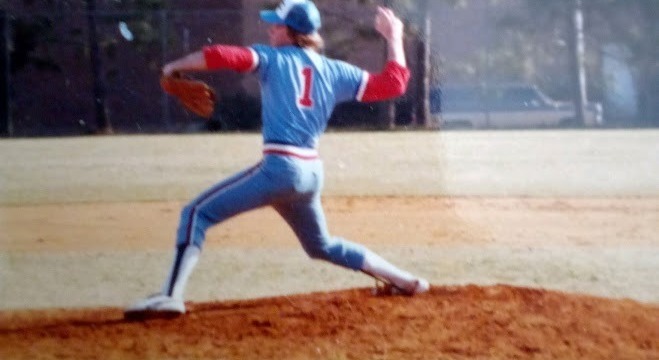Shortstop Steve Shertzer’s baseball journey began as a highly recruited pitcher

Photo: Stever Shertzer, at age 18, pitching for Kalamazoo College
By Bill Tarrant
In Gold's recent 17-4 victory over Silver and Black, Shortstop Steve Shertzer was awarded the game ball for his half-dozen highlight reel plays, leading a brilliant infield defense, where even the pitcher fielded his position.
But Shertzer’s baseball journey began as a skinny pitcher with a blazing fastball playing on elite high school and travel teams.
The 65-year-old was born in Howell, Mich. but soon after moved out to Manhattan Beach, CA. As a teenager, he moved back to Howell, where his father had arranged a tryout for his son at the high school. The Howell Highlanders over the decades have produced All-Staters, future college stars, and a first-round Major League Baseball draft pick.
Shertzer was not built like a prototypical pitcher, standing 5’ 10” and weighing all of 119 pounds. But he could chuck the ball at 94 MPH, which in the 1970s was elite speed – even iganat the major league level.
How’d he do it?
“Speed of my arm,” he says. “My favorite pitcher growing up was Nolan Ryan, so I copied his motion.”
He also had the intangibles of an elite athlete.
“You’re just a winner,” he recalled his high school coach telling him. “Every game, you pitch with a heart. You just want to win.”
Playing for a top high school team that traveled extensively around southern Michigan wasn’t a lot of fun away from the game 40 years ago: long bus rides, shitty food, poor sleep, mean-ass coaches, and forget about the homework.
“It was a much rougher ride then,” Shertzer says.
Yet he was a budding star, named 1st team All County and 2nd team All State in his junior and senior years. That led to recruitment offers from 16 major colleges “and a few major league teams.”
“Most teams gave up on me because of my size (5'10" 119),” he says.
He ended up on a travel team for the Cincinnati Reds based in Florida and touring the Southland.
He played a year at Kalamazoo College, an elite liberal arts school in southern Mich., “which was a great experience,” before calling it quits and moving back to Manhattan Beach.
But it turned out baseball wasn’t done with him.
He was asked to try out for the Los Angeles Harbor College Seahawks, one of the best community college teams of the early 1980s when they won back-to-back national titles.
At the tryout, he struck out 14 and pitched a shutout. “You just beat the national champs like it was nothing,” Shertzer recalled the coach saying.
That was the year the Seahawks repeated as champion with Shertzer on the team.
“I was doing pretty good again, good enough to get some interest from BYU and the Baltimore Orioles.”
But, alas, he was unavailable for that post-season run. “I broke my hand in a bar fight,” he recalls ruefully.
Shertzer hung up his spikes for good after that, joining Hughe’s Aircraft Company in its satellite communications division, which required a national security clearance.
And then life happened.
In February 2020, just as Covid was coming ashore from China, Shertzer suffered a near-fatal heart attack. He recovered well enough to start playing again about a year or so later. These days, Shertzer, who has managed to stay single his whole life, is working in the construction industry.
He has some amazing highlights to look back on.
He set a record in his junior year in high school with 17 strikeouts in one game, “until a guy named Jim Abbott from Flint, MI. broke it several years later. (Abbot was a highly successful pitcher in the Major Leagues from 1987-1999 despite being born without a right hand). That same year, he threw back-to-back no-hitters against the two best teams in his Michigan league.
“My favorite highlight was when I was playing for LA Harbor. I was brought in to pitch against(former New York Mets star) Daryl Strawberry, didn’t know who he was, and I didn’t care. I threw him three curve balls and he took three of the biggest swings I have ever seen and missed every one of them.”
No one wants to see his fastball, let alone that curve, even if it’s thrown underhanded in the senior softball circuit. So he’s ended up where he began his baseball life, as an elite middle infielder.
“We play the game for fun,” he notes. “But I also play to win. It’s a lot more fun to win.”
1 Comment Add a Comment?
Henry Schipper
Great story, Bill.
Amazing journey, Steve.
Thanks for letting us know.